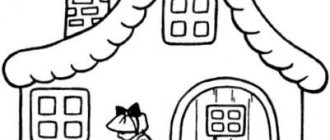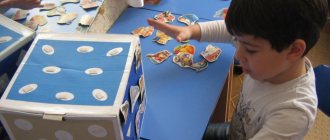Children are significantly different from adults, in everything, including their thinking. If you want to find a common language with your child and raise him correctly, excluding the slightest mistakes, you need to understand how children's thinking works and what are the features of its development.
Joint activities and conversations bring closer together
The mental activity of children, just like adults, is based on psychological aspects. After all, their development occurs with an alternating change of different types of thinking, which gradually overlap each other.
Let's look at the development of children by age:
- Infants have synthetic thinking, that is, they are sensitive to everything that happens around them. During this period of life, the baby’s consciousness is able to perceive information only through hearing and touching it.
- At 1.5 years, the ability to observe and perform any actions with surrounding objects develops.
- At 3-4 years old, in addition to these qualities, the child already develops his own ideas and images that he tries to demonstrate.
- By the age of 5, a verbal-logical type of understanding of the information that is presented to him begins to emerge. Therefore, for the development of thinking in preschool age, it is extremely important to involve children in educational games.
- In children aged 6-7 years, verbal-logical thinking comes to the fore and dominates other types of cognition, and also continues to develop from 8 to 10 years.
- Adolescents aged 11-14 begin to develop a clear need for independent knowledge of the world. Their thinking becomes more complex and moves to a new level. It is during this period, according to psychologists, that personality begins to form.
Activities with children - wonderful moments of closeness
Interesting: The importance of puzzles for the development of logical thinking in a child is enormous
Child psychologists and teachers identify several stages in the development of children's thinking. Let's look at them in more detail:
- Visually effective. The earliest stage (1.5-2 years), when babies begin to explore the world with their hands. They try to touch everything, try it on their teeth and even break it.
- Visual-figurative. Refers to the age of 3-4 years, when visual-figurative thinking joins the visual-effective type. Both types develop harmoniously, complementing each other. This kind of thinking is formed before the child goes to school. At this moment, great emphasis should be placed on drawing, appliqué, design and sculpting.
- Verbal-logical. Starts from 5-7 years. The child learns not only to talk about facts, but also to analyze everything around him, as well as voice his analysis.
- Creative. Develops the ability to create and create something new, to make non-standard decisions in design. It is noteworthy that the development of this type of thinking largely depends on parents, who must stimulate this quality. Moreover, all children have it.
Joint activities with children are a better way to spend time.
You can understand how quickly and correctly a child’s thinking develops by doing a few things:
- Comparison. It can be performed by children starting from 2 years old, comparing objects according to their characteristics, seeing the difference or similarity between them.
- Generalization. Such activity develops closer to 6-7 years. For example, you can ask the child to name several objects (cup, spoon, pan), in one word - “dishes”. Young children are unlikely to understand what is wanted from them.
- Analysis. Children begin to analyze at the age of 3-4 years. For example, a child can conduct an analysis: what paper, wood, etc. is made of. This way you can understand that he has begun to master its technique.
- Synthesis. This operation can be contrasted with analysis. A striking example of this is the development of reading skills by a preschooler. First, he studies sounds and letters, then learns to put them into syllables, words, sentences and text.
- Classification. By carrying out this operation, the child learns to identify similarities or differences between the objects and phenomena around him. And after identifying common features, it classifies objects into one group, for example, dividing toys into groups made from the same material.
Joint activities bring us closer together
What kinds of exercises are there to develop logic?
Logic is a multifaceted concept, so one set of exercises is not enough. Tasks can be linguistic, mathematical, artistic. You can find them in the books of famous teachers and psychologists. Specialists from the Research Center for Neuropsychology named after A.R. Luria are the authors of many manuals for preschoolers, designed to develop thinking, memory, attention and other mental functions, so they will advise parents on suitable materials for teaching their child.
You can start with something simple:
- language games in the form of “question-answer”;
- classes with cubes, sticks, colored cards;
- drawing according to instructions, completing missing elements;
- riddles for calculating an object from a description;
- solving puzzles, including corresponding online games on the Internet, etc.
The main thing is to organize classes in a playful way. This way the child will be able to take the initiative without perceiving what is happening as learning and developing skills on a subconscious level.
What advantages does advanced logic provide?
Underdevelopment of thinking is a pressing problem of the present time. It has many negative consequences. The lack of development of the ability to think logically leads to the fact that an adult is unable to:
- think systematically;
- establish cause-and-effect relationships;
- resist manipulation;
- draw the right conclusions;
- argue your point of view;
- refute incorrect statements.
Therefore, practicing logic is an effective method of developing intelligence. This is an investment in the child’s future, where he will be able to think outside the box and go beyond the mold. Regular mental training is a useful habit, because new neural connections need to be formed throughout life.
Why develop a child on your own if there are teachers?
Educational methods develop thinking, but it is also important for parents to engage with their baby.
Lessons give new knowledge, but it is home exercises with exercises that help develop mental abilities that help to assimilate them. In a familiar situation, everyone feels much more comfortable - it’s easier to express their thoughts, there is no fear of making mistakes, because no one bothers you to test yourself at a new stage of the exciting training process. There are many more reasons for such activities:
- Antistress. With developed thinking, it is much easier to cope with emotions when solving complex problems.
- Save time. After fruitful training, children are able to set priorities, managing their leisure time independently. They complete their lessons faster.
- Creativity. New solutions and innovative ideas are in demand not only at school. They help clearly define the boundaries between stereotypes, finding opportunities to go beyond them.
- Implementation in society. Insufficient thinking potential limits the scope of development. To become truly successful, good grades are not enough—you also need motivation. A specialist with a flexible mind has a much greater chance of proving himself.
Types of children's thinking
The thinking process is a rather complex structure and is divided into four main types:
- Visually effective. It is to people with this type of thinking that the epithet “golden hands” is most often applied. This type is typical for all children, without exception. Any child loves to disassemble and reassemble toys, explore and try something new; they are driven by the goal of learning the unknown.
- Figurative. This type of thinking begins to form already in preschool age, at about 5-6 years. Children show their interest in drawing, assembling construction sets; they are accustomed to playing, imagining various figures and images in their minds. During this period, it is the kindergarten teacher who plays a major role on the child, who, first of all, is responsible for the development of imaginative thinking. In kindergarten, a child is taught to come up with various images, describe them, remember and retell various stories, and play out various life situations.
- Boolean. When a child enters school, the period of development of logical thinking begins. He is taught to think analytically, to look for the main thing in the material presented for study, and to draw conclusions. Unfortunately, most modern schools approach the development of logic in a one-sided and formulaic manner, without a creative approach. Of course, it is rare that a teacher has the opportunity to approach this issue creatively due to the special workload and density of the program. As a result, the child is faced with the need to perform the same tasks every day, which, if they differ, are in small things. The essence of the approach remains unchanged - mechanical adherence to certain algorithms. All this does not contribute to the harmonious development of the child, so in this case, only parents can help the child, who will support him in finding non-standard solutions to classic tasks.
- Creative. Many people wonder how to develop creative thinking in a child. The answer is simple - communication. It is communication with the people around him that will help him form his own points of view on a particular issue. Reading and discussing books, watching educational programs - all this will be useful during a normal conversation. You should not dismiss your child in his desire to learn something new and discuss it with you. It is conversation that helps a child develop communication skills and form his own opinion.









